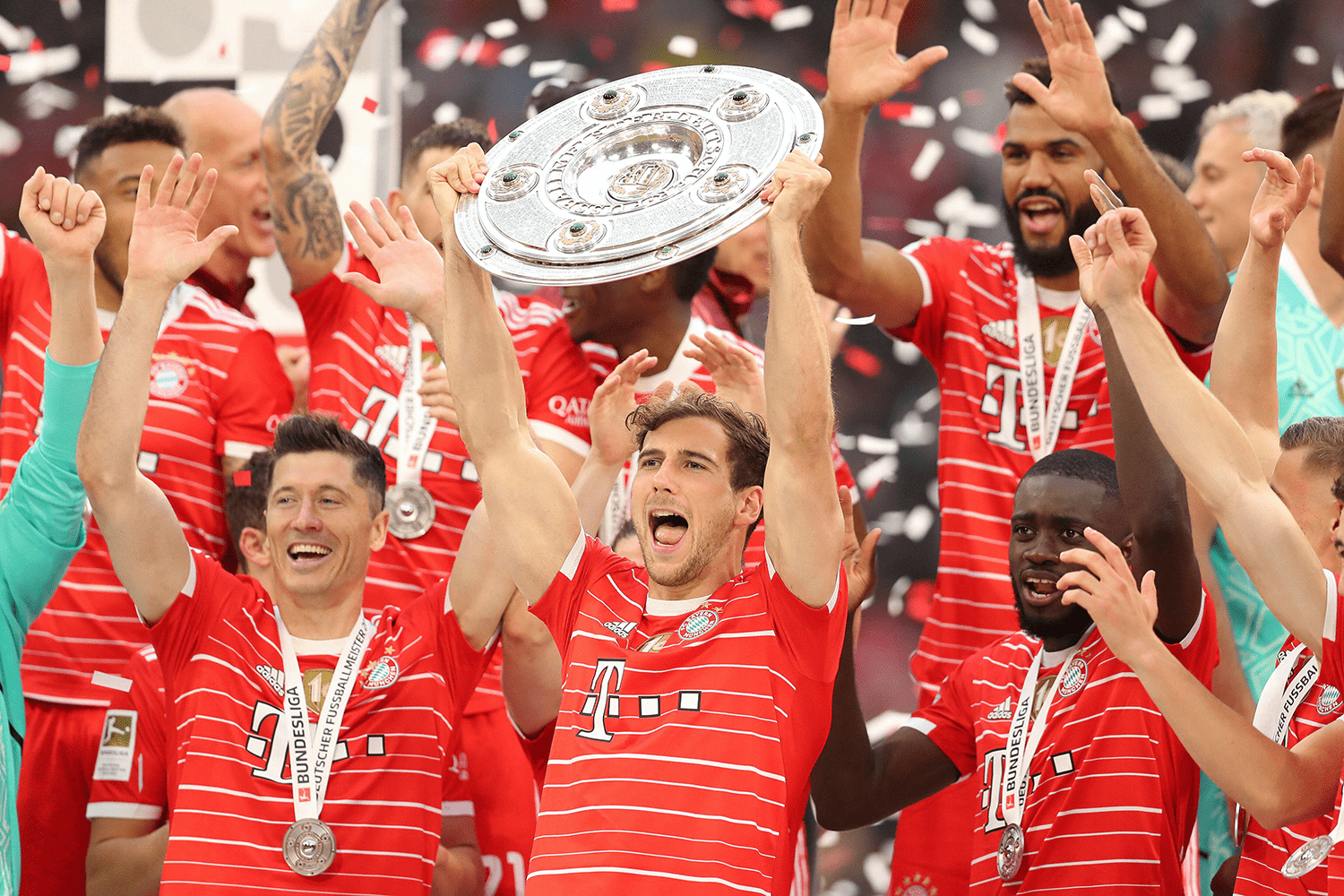Another year of Bundesliga is nearly upon us. The opening round of fixtures kicks off this weekend, so let’s examine the prevailing narratives and speculate on what we might expect from the teams and players in 2022/23.
This article is available in German here. Dieser Artikel ist auf Deutsch verfügbar.
Expected Goal (xG) Performance, Bundesliga 2021/22
Let’s first take a quick look back at the table from last season. The table here shows the expected goal difference for each team in 2021/22 in red and their actual goal difference in blue – both excluding penalties.
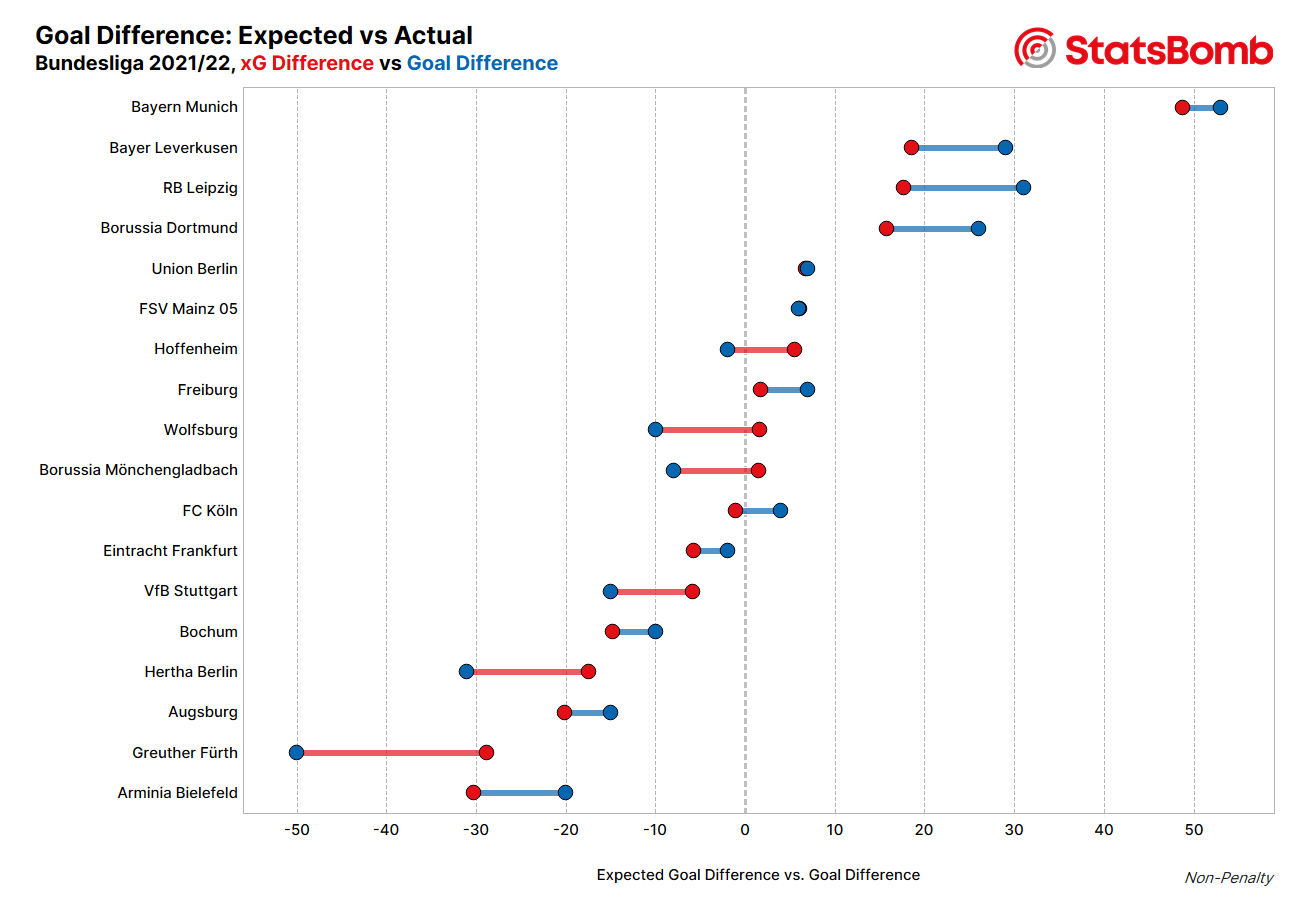
- A revelation that will surprise no one: Bayern Munich were far superior to the rest of the league once again. They won their 10th Bundesliga title in a row – the first German side ever to achieve the feat – and did so comfortably. Their dominance on the pitch was perhaps even greater than their eight-point winning margin suggested -- their expected goal difference was 2.5x greater than the next-best team.
- Arminia Bielefeld had the 3rd-largest overperformance between their actual goal difference and their expected goal difference – and still finished relegated in 17 The heroics of goalkeeper Stefan Ortega – who prevented nearly ten goals above expected based on the shots he faced - behind a poor defence was not enough to save Bielefeld, but did earn him a move to Manchester City.
- Hoffenheim, Mönchengladbach and Wolfsburg all finished squarely in midtable but could challenge the European places again with some improvement. They all had similar expected goal differences to Union Berlin and Freiburg but fell short based on their actual goal difference.
What does this mean ahead of next season?
Bayern Munich: No more Robert Lewandowski
The biggest story coming into the 2022/23 season is the loss of the league’s best strikers. Erling Haaland’s move away from Dortmund was telegraphed from the day he joined the club, but Robert Lewandowski’s transfer from Bayern to Barcelona was more of a surprise. Many expected him to stay for at least one more season, especially with the form he was in.
Although he may have slowed down a touch last season, scoring only 35(!) league goals compared to 41 the season before, the loss of Lewandowski undoubtedly came ahead of when Bayern would have ideally let him go. This was not the timely sale of a player in decline, but the loss of one of the best – if not the best - strikers in world football.
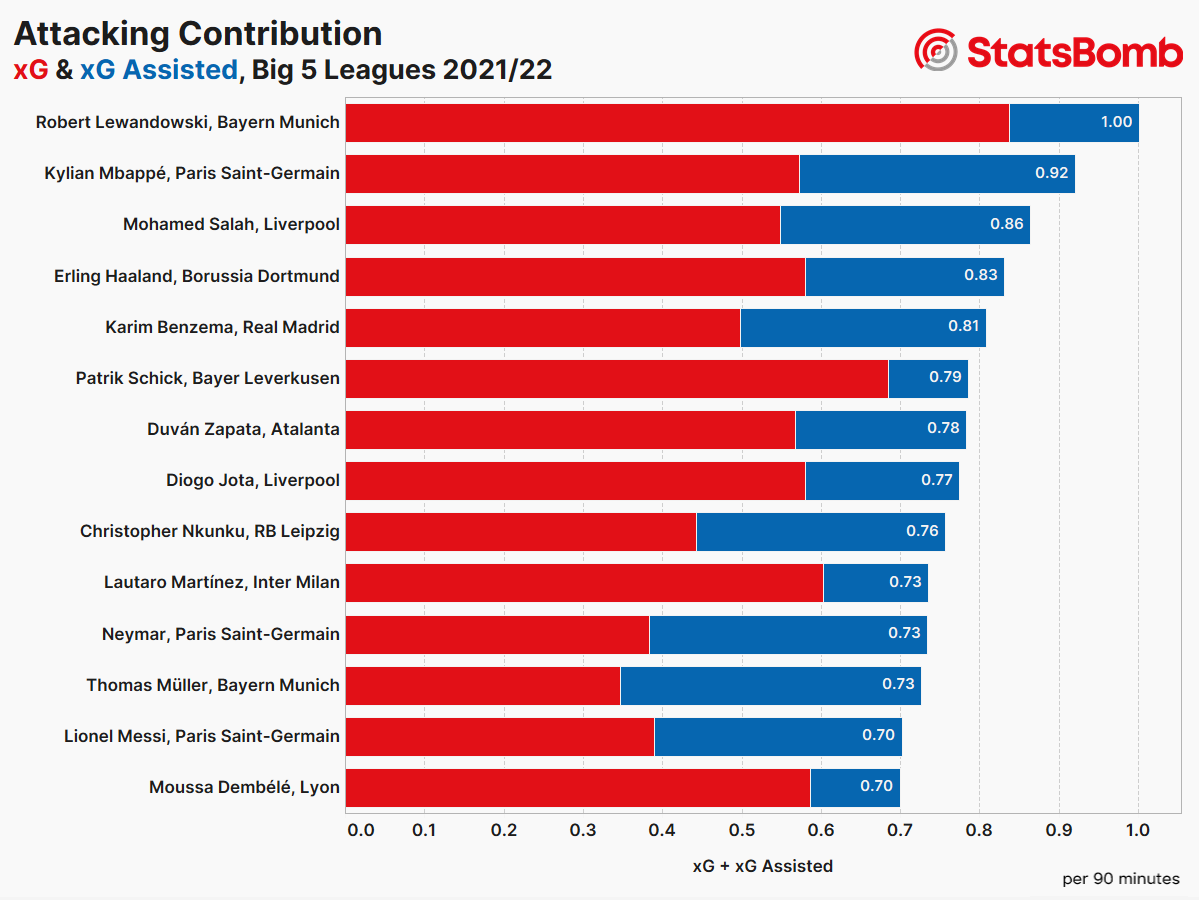
There are two sides to this coin. One side shows that Bayern have lost 33% of their expected goal output in the league from last season. Any other team in the Bundesliga would scheisse their underwear at the prospect of losing a full third of their goals from the side. But, the other side of this coin shows that even removing the 28.9 xG Lewandowski accrued last season from Bayern’s tally entirely, they’d still have had the best attack in the league comfortably.
Even more interesting is the decision to (so far) replace Lewandowski’s output with Sadio Mané. Mané will not be the same attacking focal point that Lewandowski was, but there’s no reason he shouldn’t dovetail just as effectively with the rest of Bayern’s attacking arsenal. It’s logical that Julian Nagelsmann will be plotting to replace Lewandowski’s goal threat in aggregate, and looking at their attacking options…
Mané, Sané, Gnabry, Müller, Musiala, Sabitzer, Coman
… it’s easy to see why Bayern will fancy their chances of making up the majority of goals they’ve supposedly lost.
RB Leipzig: A change in approach
Looking to close the gap to Bayern and overtake the teams around them to repeat their 2nd-placed finish from 2020/21 is RB Leipzig. Only they’re doing things differently this time around.
Replacing now-Bayern boss Nagelsmann was never going to be easy, and Jesse Marsch lasted only half a season in his attempt to succeed him. Former Schalke and Spartak Moscow manager Domenico Tedesco came in after Marsch was let go and steadied the ship to secure Champions League football.
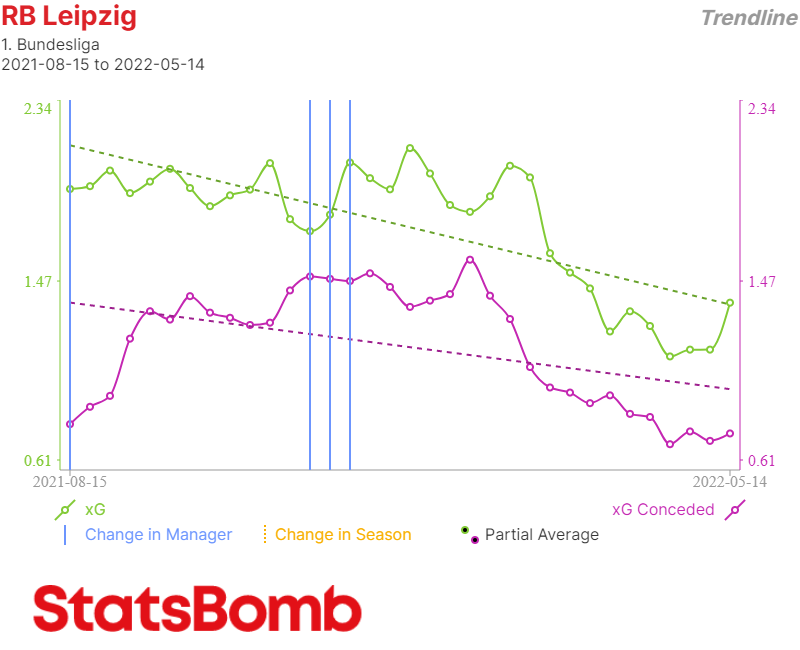
However, the style of play was not one we’ve come to expect in those parts. Tedesco abandoned the traditional RB fast pressing and faster transitioning football and set about making Leipzig a more secure and pedestrian unit, reducing the number of risks the team took in and out of possession. Their PPDA dropped from 7.1 to 10.4.
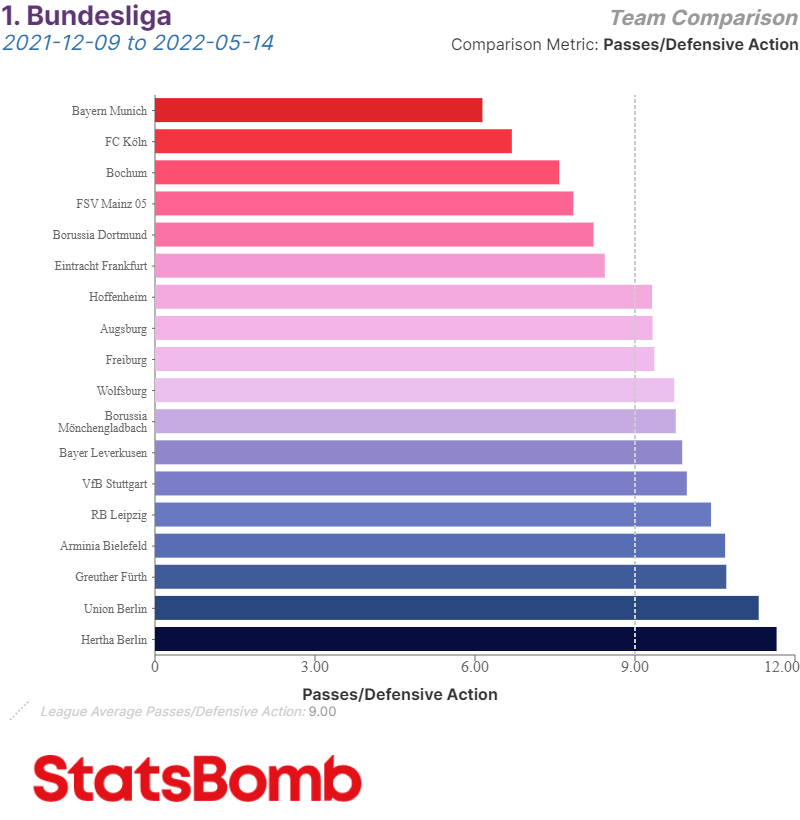
The ends justified the means as Leipzig reached the Europa League semi-finals and had the 2nd-best expected goal difference in the Bundesliga after Tedesco was appointed. Will they be able to repeat the trick this season?
On-Ball Value: Where on the pitch did Bundesliga teams create their threat?
On-Ball Value (OBV) is our possession value model, a method of measuring the value of each action that took place on the pitch based on the positive or negative impact it had on a team’s likelihood of scoring (or conceding). This allows us to give credit to the most valuable actions in a possession chain – those that had the greatest impact on increasing a team’s chances of scoring – beyond the pass prior to the shot or the shot itself.
We can use OBV to assess where each team created the most value: which areas were they most dangerous to the opposition?
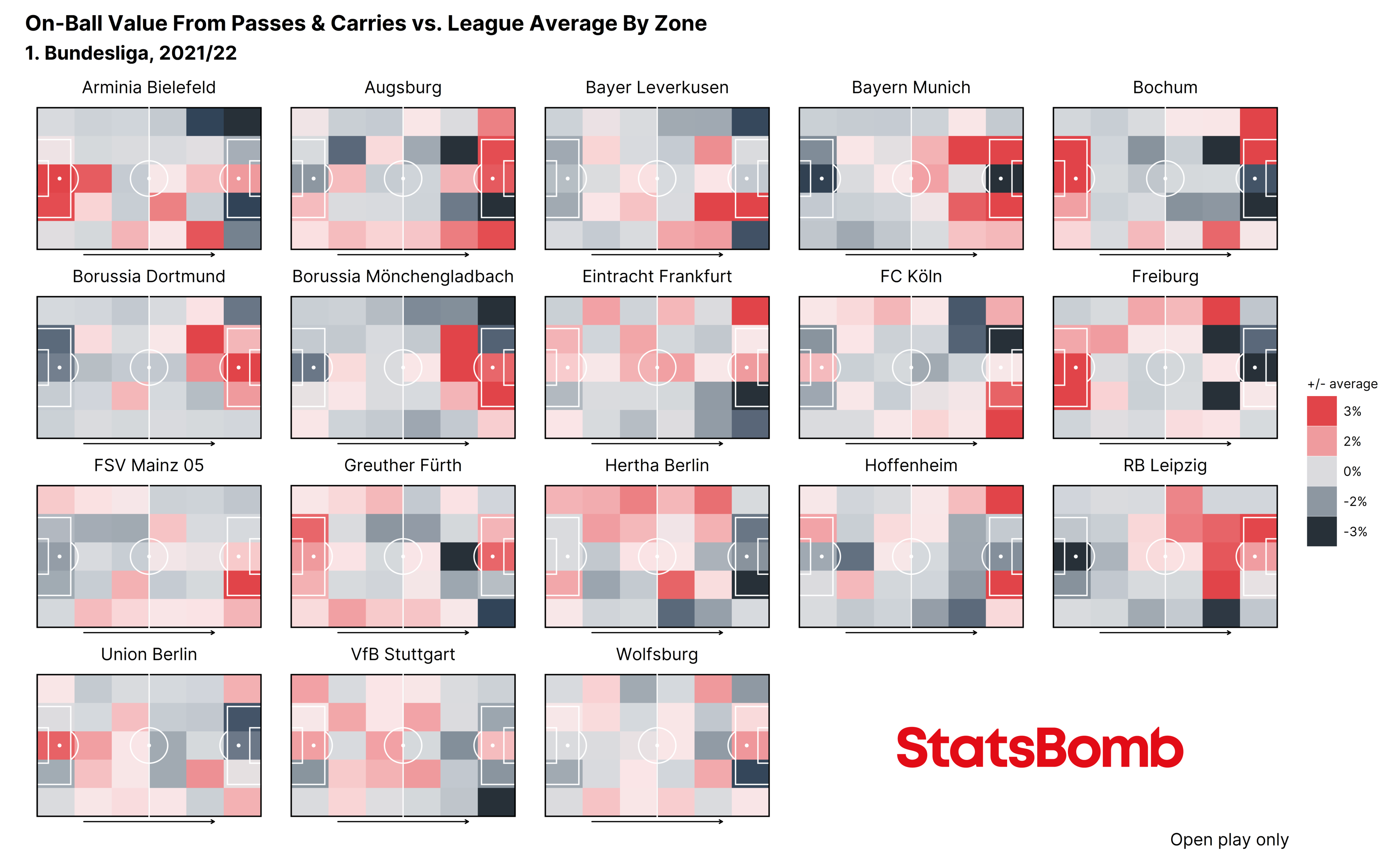
We can see:
- The importance of the half-space to the teams at the top of the league. Bayern, Leverkusen, Dortmund and Leipzig all exploited this area to attack the box with passes or dribbles.
- Arminia Bielefeld and Bochum preferred to play the ball long from the back. Union Berlin, who finished 5th, also fell into this category, proving that you don’t need to play the ball out from the back to succeed in a major European league.
- Hoffenheim looked to play to the wings and create from crosses into the box. However, we could expect this to change under new manager André Breitenreiter, whose FC Zürich side won the Swiss Super League title in 2021/22 without depending on crosses for chance creation.
Bayer Leverkusen are all right
It’s noticeable in Bayer Leverkusen’s OBV heatmap that they create a lot of their threat down their right-hand side. This will come as no surprise to regular watchers of Die Werkself: they’ve been watching Moussa Diaby and Jeremie Frimpong terrify Bundesliga defences all season long.
Florian Wirtz was the player that took the majority of headlines and acclaim at Leverkusen, but in his two teammates, Leverkusen have two of the six players that created the most OBV from ball carrying in the Bundesliga last season. Given they tend to operate in slightly different areas of the pitch – Diaby a wide attacker and Frimpong a flying wing back – it’s interesting to compare where their most valuable ball carries came from and where they moved the ball to.
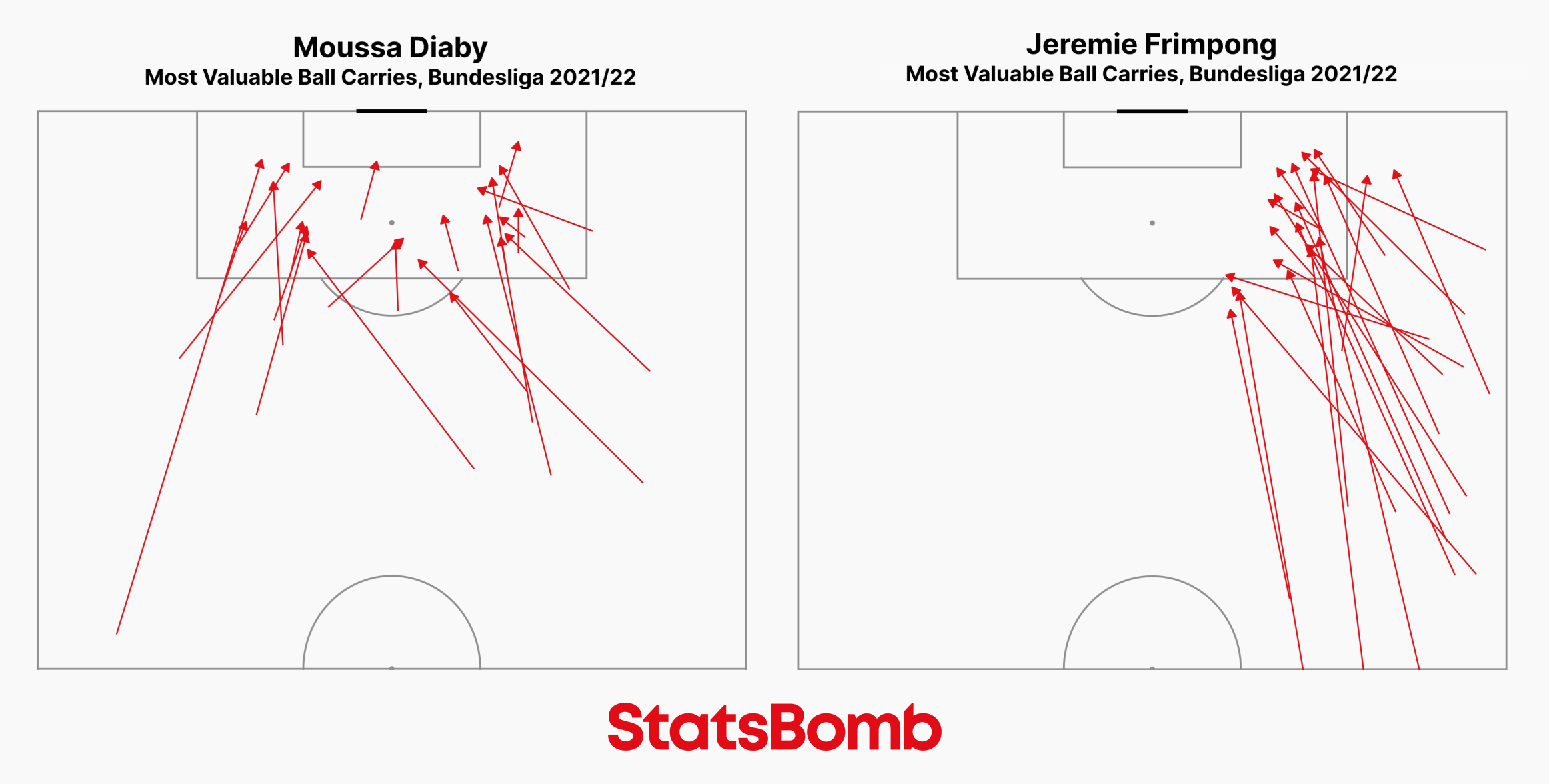
Frimpong’s map is evidence that he’s a player that excels in fast-paced transitions and in breaking opposition blocks, carrying the ball with speed and control into the opponent’s final third and penalty area. There was an end product following his runs too, creating six assists from 4.1 xG Assisted.
Diaby’s map is interesting in comparison. Though often starting on the right or left flank, Diaby’s most valuable runs came from the half-spaces, picking the ball up in the inside channel and driving towards goal, wriggling through the defence and into a position to shoot or square the ball to a teammate. Diaby was the team's primary creative force, behind only Thomas Müller and Christopher Nkunku for open play xG Assisted in the league last season.
Indeed, Diaby was one of the most improved players in the Bundesliga last season. Under Gerardo Seoane, Leverkusen played a transition game in attack which focused on utilising the sheer mobility of players such as Diaby and Wirtz. Diaby got more touches in the box, resulting in a significant uptick in the quality of shots he was taking, measured by his xG per shot.
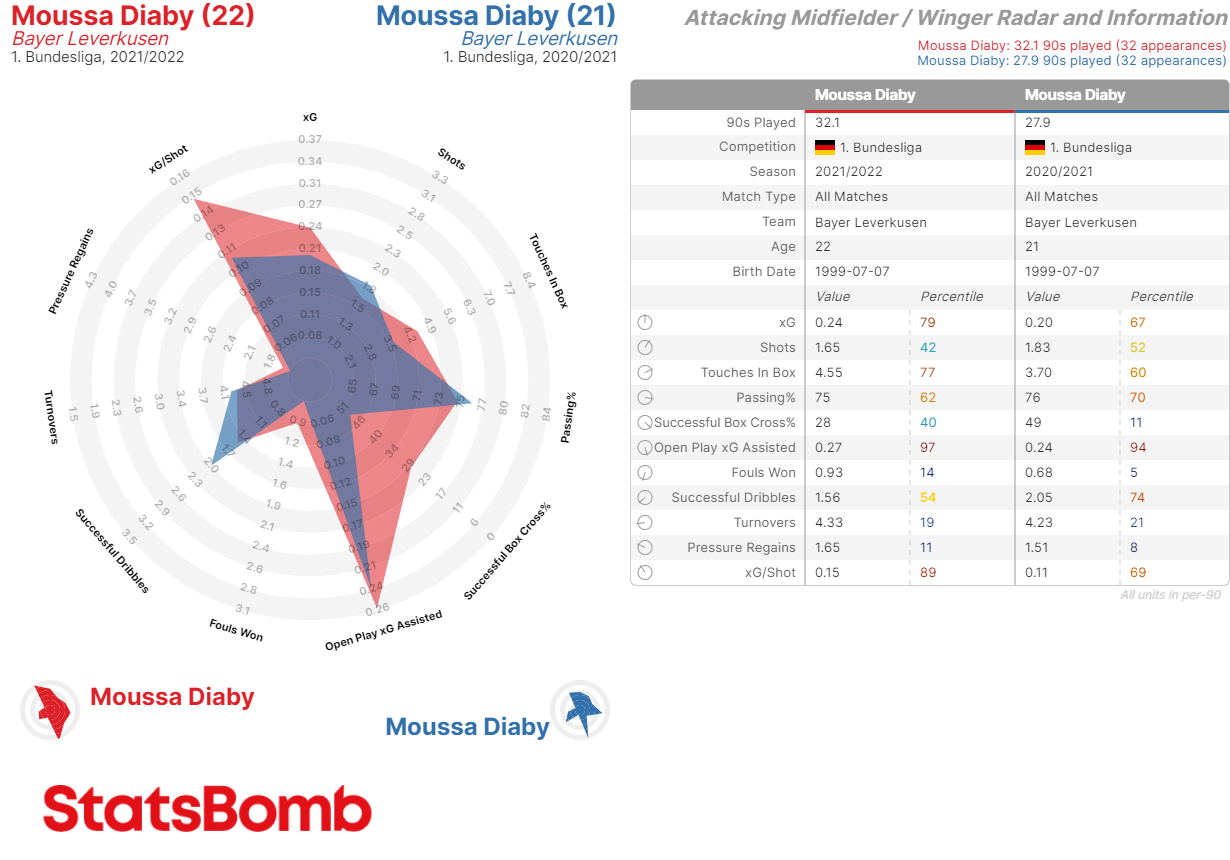
Where do teams in the Bundesliga press?
In the league that brought gegenpressing to life in the modern era, the pressing game has always been particularly interesting in a league that plays in transition much more than its major European counterparts. Let’s look at where each team pressed in 2021/22.
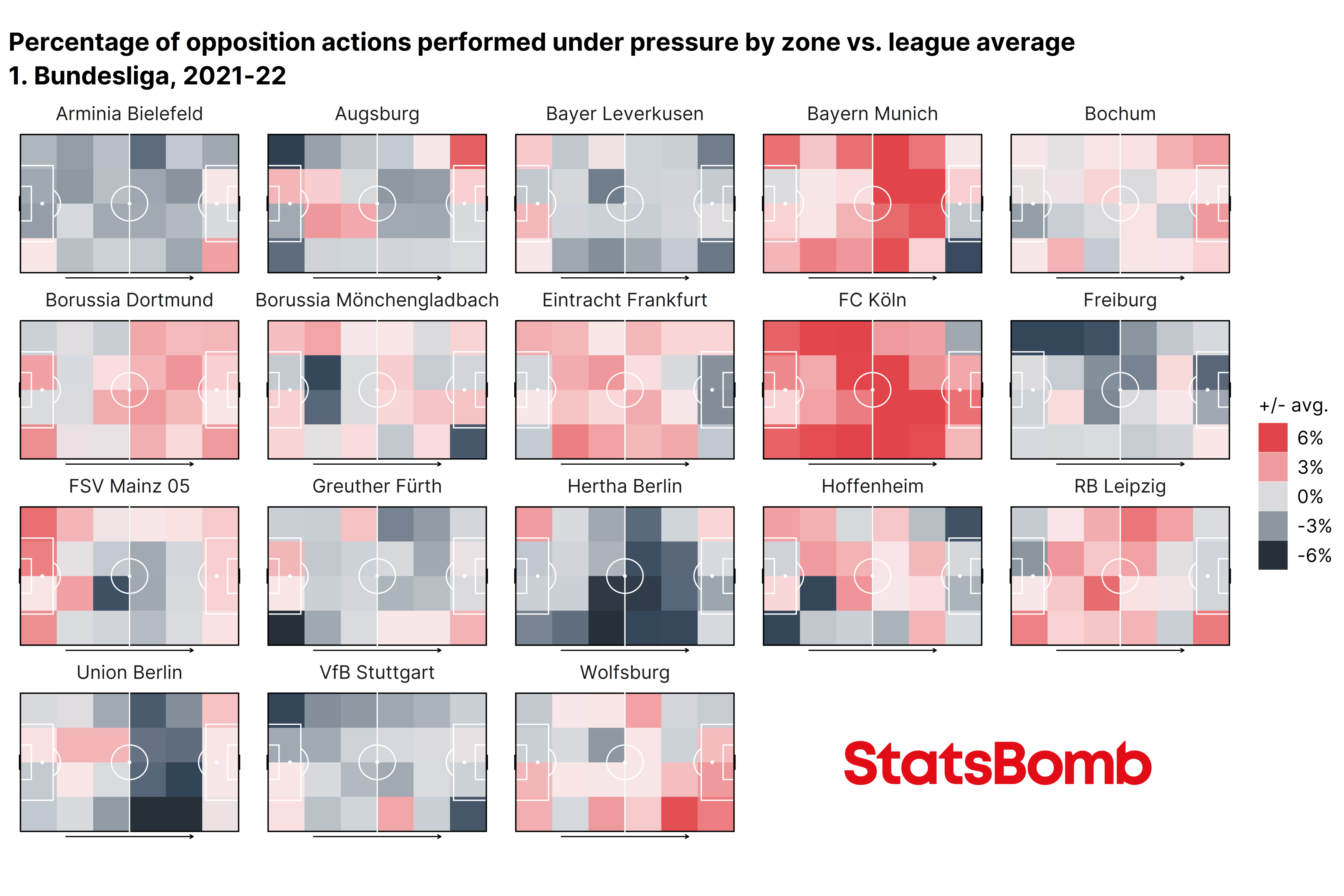
- It’s impossible to ignore FC Koln, the most aggressive side in the Bundesliga last season. No matter what the opposition did or where they did it, Koln were quick on the scene: 29% of their opponent’s pass receipts were pressured, tackled, or fouled within two seconds. Steffen Baumgart has made himself a coach to look out for.
- Neither Berlin side were particularly active in midfield. Union and Hertha tended to allow their opponents time and space on the ball in the attacking and middle third, preferring to retain their shape and stay in a compact block.
- Borussia Mönchengladbach struggled to close their opponents down when they got to central areas in the final third, despite having a reasonably active press in the attacking and middle thirds. A sign that they were vulnerable when the press was broken, perhaps?
Line Breaking Passes
What’s a StatsBomb season preview without having fun with our latest metric?
Using our StatsBomb 360 data - freeze frame event data containing the location of all players in the frame around every event – we’re now able to identify when a pass has broken an opposition defensive line. Here are the top ten line-breaking passers in the 2021/22 Bundesliga.
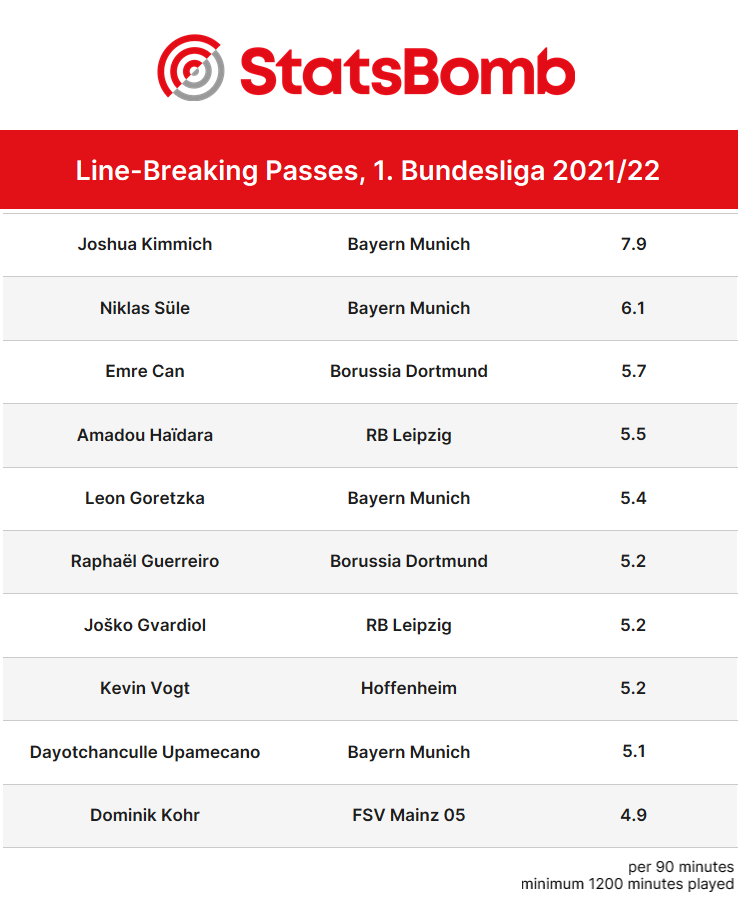
Perhaps most notable is the appearance of Niklas Süle at second in the list after he made the free transfer from Bayern Munich to Borussia Dortmund. With Mats Hummels now 33, Dortmund have moved to find a long-term replacement for him at centre back, particularly his ability to progress the play from out of defence. Between Niklas Süle and fellow new signing Nico Schlotterbeck from Freiburg (20th in the line-breaking passes list), Dortmund will be hoping they have secured the future of their defence for several seasons to come.
Key Transfers
Karim Adeyemi – RB Salzburg to Borussia Dortmund
How do you replace Erling Haaland? Well, why not replace him with a player that already replaced him? Adeyemi will be hoping to make a similar step up from Austria to Germany.
The forward is of a slightly different profile to his predecessor, profiling more like a wide attacker than the complete centre forward profile of Haaland. Dortmund likely planned to play Adeyemi off their other new recruit Sébastien Haller before Haller’s health concerns were diagnosed, so it’s not yet clear exactly where and how Adeyemi will feature.
One thing to note is that our Similar Player Search tool suggests that the forward that Adeyemi is most similar to in the Big 5 major European leagues is Kylian Mbappé.
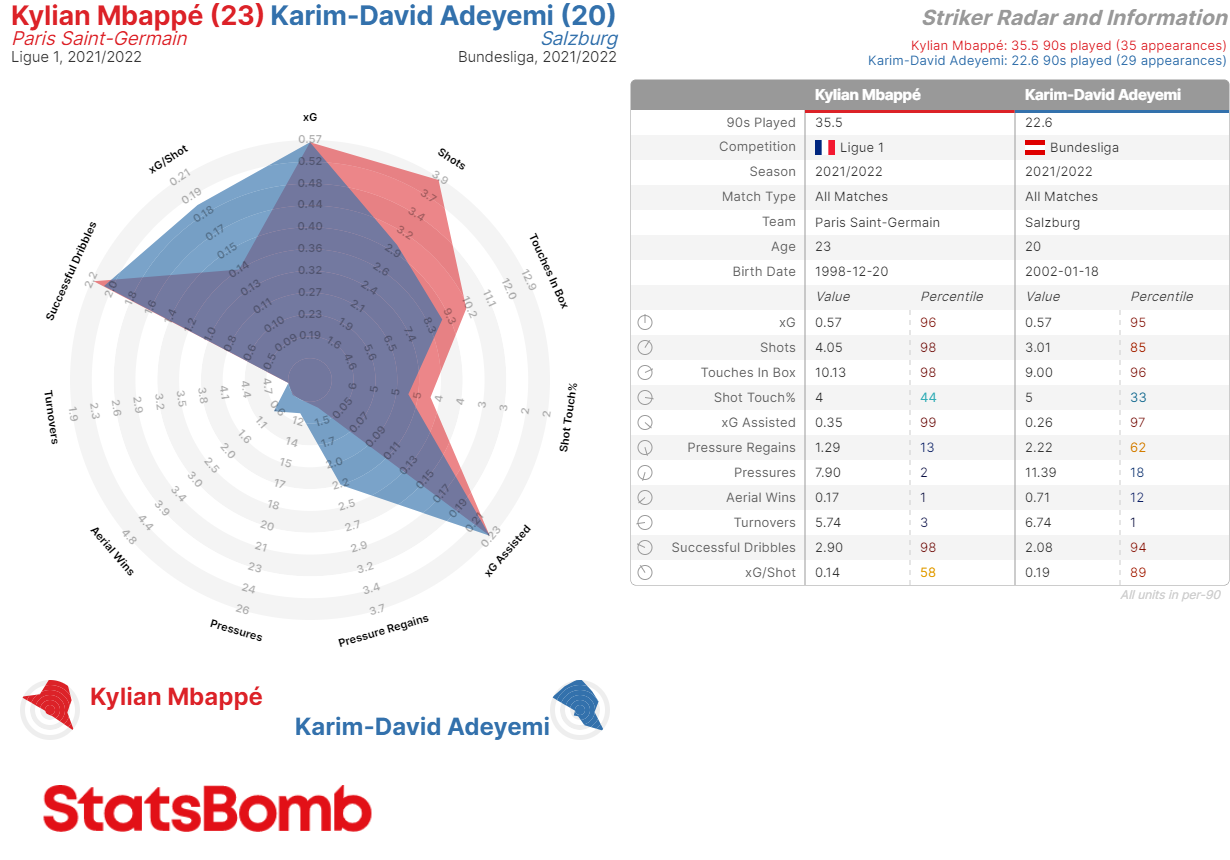
David Raum – Hoffenheim to RB Leipzig
It only took one season of Bundesliga football to convince Leipzig to raid Hoffenheim for David Raum.
A star performer in 2021/22, the left wing back only made his first top-flight appearance in August 2021 following his free transfer move from Greuther Fürth but showed straight away that he belonged at this level.
Raum contributed heavily to Hoffenheim’s attack and was behind only Thomas Müller, Christopher Nkunku, and Moussa Diaby for open play xG Assisted in the league last season. He also created more On-Ball Value with his passing than any other player.
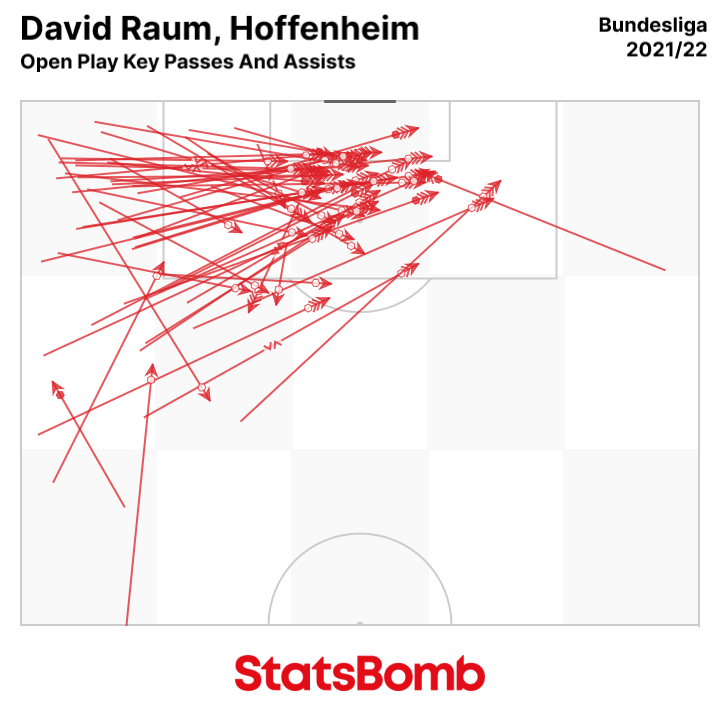
Adam Hložek– Sparta Prague to Bayer Leverkusen
The news that Leverkusen have added another tricky attacker that can play across the attacking band will not have gone down well with Bundesliga defences this summer.
Adam Hložek has been touted for a move to the major European leagues before, and he finally got it this summer, moving to the Bundesliga from Czech First League side Sparta Prague. Hložek played over 100 top-flight games for Sparta, appeared in the Europa League, and won 18 caps for the Czech Republic. All by the age of 19.
Having featured out wide, as a centre forward, and playing off the central striker, Hložek has a versatility that should see him get minutes straight away for Leverkusen, particularly with the injury suffered by Florian Wirtz in the second half of the 2021/22 campaign.
Capable of competing in the air, beating players off the dribble, and creating and getting goals himself, many will be curious to see how quickly Hložek can make the step up.
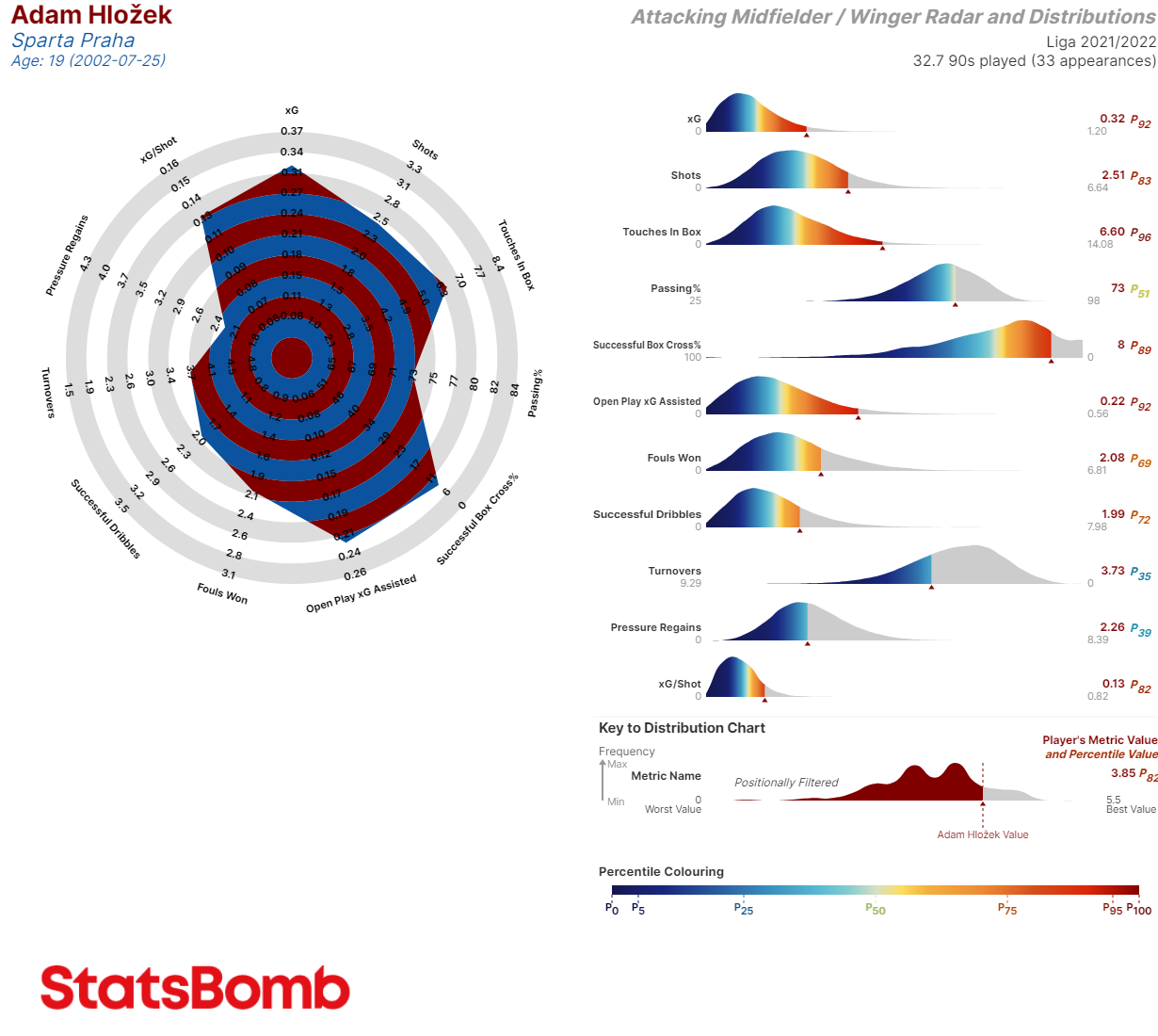
A note on the teams promoted from Bundesliga 2.
We welcome Schalke 04 and Werder Bremen back to the Bundesliga after both won immediate promotions to the top tier following relegation in 2020/21.
Schalke won the title by two points over Bremen, but there was virtually nothing between the two sides in the underlying numbers; both had the two best attacks and two best defences by xG in the Bundesliga 2. in 2021/22.
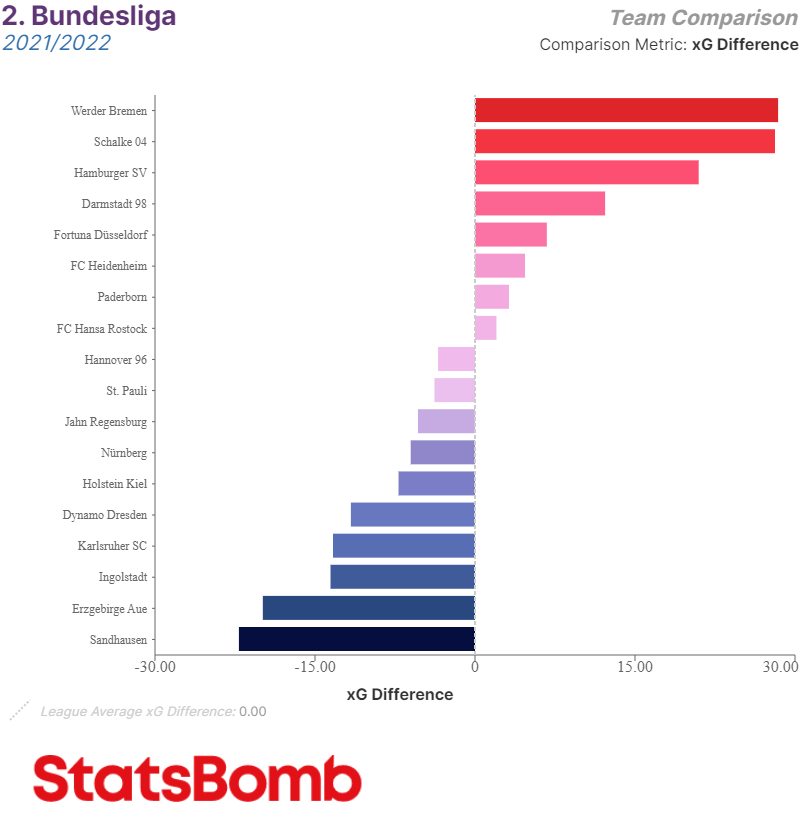
With no Haaland and no Lewandowski, there’s a vacancy available to be the next star of the Bundesliga in 2022/23. Let’s see who can step up to the plate.
